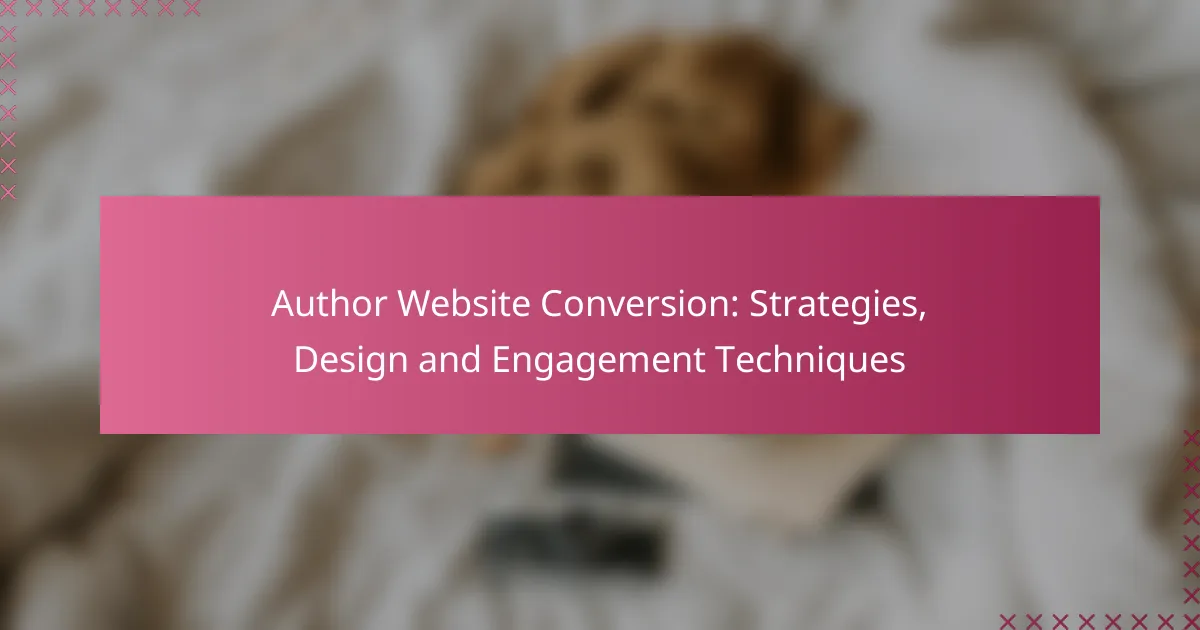Creating an effective author website is essential for boosting conversion rates and engaging with readers. By focusing on strategic design elements and user experience, authors can transform casual visitors into dedicated fans. Incorporating clear calls to action and compelling content, alongside effective engagement techniques, can significantly enhance brand visibility and drive sales.

How can author websites increase conversion rates?
Author websites can significantly boost conversion rates by implementing strategic design elements and engagement techniques. Focusing on user experience, clear calls to action, and compelling content can turn casual visitors into loyal readers or customers.
Optimized landing pages
Optimized landing pages are crucial for converting visitors into leads or sales. These pages should be tailored to specific audiences, featuring clear messaging and a single focus, such as signing up for a newsletter or purchasing a book. A/B testing different layouts and content can help identify what resonates best with your audience.
Consider using strong visuals and concise copy that highlights the benefits of your offerings. Ensure that the landing page loads quickly, ideally within a few seconds, to reduce bounce rates and keep visitors engaged.
Effective call-to-action buttons
Effective call-to-action (CTA) buttons are essential for guiding visitors toward desired actions. Use action-oriented language, such as “Download Now” or “Join the Community,” to create urgency and clarity. Position these buttons prominently on the page, ensuring they stand out visually.
Experiment with different colors and sizes to see what attracts more clicks. A good rule of thumb is to place CTAs above the fold and at the end of content sections to capture attention at key moments.
Engaging content strategies
Engaging content strategies can keep visitors on your site longer and encourage conversions. Use storytelling techniques to connect with your audience emotionally, and consider incorporating multimedia elements like videos or podcasts to enhance the user experience.
Regularly update your blog with relevant topics that reflect your expertise and interests. This not only improves SEO but also positions you as a thought leader in your niche, encouraging visitors to return for more insights.
User-friendly navigation
User-friendly navigation is vital for ensuring that visitors can easily find what they are looking for. A clear menu structure with logical categories helps users browse your site without frustration. Limit the number of menu items to avoid overwhelming visitors.
Consider implementing a search function to allow users to quickly locate specific content. Breadcrumbs can also enhance navigation by showing users their current location within the site hierarchy.
Mobile responsiveness
Mobile responsiveness is essential as more users access websites via smartphones and tablets. Ensure your site adapts seamlessly to different screen sizes, maintaining functionality and readability. A responsive design can improve user experience and boost conversion rates significantly.
Test your website on various devices and browsers to identify any issues. Tools like Google’s Mobile-Friendly Test can help you assess your site’s performance and make necessary adjustments to enhance mobile usability.

What design elements enhance user engagement?
Effective design elements significantly boost user engagement by making the website visually appealing and easy to navigate. Key aspects include visual hierarchy, color psychology, and consistent branding, all of which play a vital role in guiding user behavior and enhancing their overall experience.
Visual hierarchy
Visual hierarchy refers to the arrangement of elements on a page to guide users’ attention in a specific order. By using size, contrast, and spacing, you can emphasize important content, making it easier for visitors to find what they need. For example, larger headings draw attention first, while smaller text can provide supporting information.
To implement effective visual hierarchy, prioritize key elements like calls to action (CTAs) and essential information. Use contrasting colors or bold fonts for these elements to ensure they stand out. Avoid cluttering the page, as too many competing elements can confuse users and reduce engagement.
Color psychology
Color psychology explores how different colors evoke emotions and influence user behavior. For instance, blue often conveys trust and professionalism, while red can create a sense of urgency. Choosing the right color palette can enhance user engagement by aligning with the desired emotional response.
When selecting colors, consider your target audience and the message you want to communicate. A well-thought-out color scheme can improve readability and create a cohesive look. Aim for a balance of colors that reflect your brand identity while ensuring accessibility for all users, including those with color vision deficiencies.
Consistent branding
Consistent branding across your website fosters recognition and trust among users. This includes using the same logo, color scheme, typography, and tone of voice throughout the site. Consistency helps create a unified experience that reinforces your brand identity and encourages user loyalty.
To maintain consistent branding, develop clear guidelines for your website’s design elements and content. Regularly review your site to ensure all components align with these guidelines. Avoid sudden changes in design or messaging, as this can confuse returning visitors and diminish their engagement.

Which engagement techniques drive sales?
Effective engagement techniques that drive sales include email marketing campaigns, social media integration, and interactive content features. These strategies foster connections with potential customers, enhance brand visibility, and ultimately lead to increased conversions.
Email marketing campaigns
Email marketing campaigns are a powerful tool for driving sales by directly reaching out to your audience. Personalized emails that offer exclusive content, discounts, or updates can significantly increase engagement and conversion rates.
To maximize effectiveness, segment your email list based on user behavior and preferences. Aim for open rates of around 20-30% and click-through rates of 2-5% as benchmarks for success.
Consider using A/B testing to refine subject lines and content. Avoid overwhelming subscribers with too many emails; a frequency of one to four emails per month is often optimal.
Social media integration
Integrating social media into your author website can enhance visibility and drive sales. Platforms like Instagram, Facebook, and Twitter allow authors to share updates, engage with readers, and promote their work effectively.
Utilize social sharing buttons on your website to encourage visitors to share content easily. Regularly post engaging content, such as behind-the-scenes looks or reader polls, to foster community and keep your audience invested.
Consider running targeted ads on social media to reach specific demographics. A budget of a few hundred dollars can yield significant returns if focused on your ideal reader base.
Interactive content features
Interactive content features, such as quizzes, polls, and surveys, can significantly enhance user engagement on your website. These elements encourage visitors to participate actively, making them more likely to remember your brand and convert into customers.
For example, a quiz that helps readers find their next favorite book can be a fun way to engage them while subtly promoting your work. Ensure that interactive elements are mobile-friendly, as many users access websites via smartphones.
Track user interactions to gather insights about your audience’s preferences. This data can inform future content and marketing strategies, leading to improved sales outcomes. Aim for a balance between interactivity and ease of use to avoid overwhelming visitors.

What metrics should authors track for success?
Authors should track key metrics such as conversion rates, bounce rates, and user behavior to gauge the effectiveness of their websites. Monitoring these metrics helps identify areas for improvement and enhances overall engagement with visitors.
Conversion rate optimization
Conversion rate optimization (CRO) focuses on increasing the percentage of visitors who take desired actions, such as signing up for a newsletter or purchasing a book. To improve conversion rates, authors can test different elements on their websites, such as call-to-action buttons, landing page designs, and content layouts.
Utilizing A/B testing can be particularly effective, allowing authors to compare two versions of a webpage to see which one performs better. Aim for a conversion rate of around 2-5% as a benchmark, but remember that this can vary widely depending on the niche and audience.
Bounce rate analysis
Bounce rate measures the percentage of visitors who leave a site after viewing only one page. A high bounce rate may indicate that the content is not engaging or relevant to visitors. Authors should strive for a bounce rate below 40%, but this can vary based on the type of content and audience expectations.
To reduce bounce rates, authors can improve page load times, enhance content quality, and ensure that navigation is intuitive. Regularly reviewing analytics can help identify pages with high bounce rates that may need adjustments.
User behavior tracking
User behavior tracking involves analyzing how visitors interact with a website, including which pages they visit, how long they stay, and where they click. Tools like Google Analytics provide insights into user behavior, helping authors understand what content resonates most with their audience.
By tracking user behavior, authors can identify trends, optimize content placement, and enhance user experience. Consider setting up heatmaps or session recordings to visualize user interactions, which can reveal areas for improvement and inform future design decisions.

How can authors leverage SEO for better visibility?
Authors can enhance their online visibility by implementing effective SEO strategies that improve their website’s ranking on search engines. This involves optimizing content, using relevant keywords, and ensuring a user-friendly site structure.
Understanding Keywords
Keywords are the terms and phrases that potential readers use to search for content. Identifying the right keywords involves researching what your target audience is searching for and incorporating these terms naturally into your website content. Tools like Google Keyword Planner or SEMrush can help you find relevant keywords.
Focus on long-tail keywords, which are more specific phrases that often have less competition. For example, instead of targeting “books,” consider “best mystery novels for young adults.” This approach can lead to higher conversion rates as it attracts a more targeted audience.
On-Page SEO Techniques
On-page SEO refers to optimizing individual pages to rank higher and earn more relevant traffic. Key techniques include using keywords in titles, headers, and meta descriptions, as well as ensuring that images have descriptive alt text. A well-structured URL that includes keywords can also improve visibility.
Ensure your content is high-quality and provides value to readers. Engaging, informative articles that answer common questions or solve problems are more likely to be shared and linked to, further boosting your SEO efforts.
Building Backlinks
Backlinks are links from other websites to your own, and they play a crucial role in SEO. High-quality backlinks signal to search engines that your content is credible and valuable. To build backlinks, consider guest blogging, collaborating with other authors, or participating in online forums related to your niche.
Focus on obtaining links from reputable sites within your genre. For instance, if you write historical fiction, seek backlinks from history blogs or literary review sites. This targeted approach can significantly enhance your site’s authority.
Monitoring and Adjusting SEO Strategies
Regularly monitoring your SEO performance is essential for ongoing success. Use tools like Google Analytics to track website traffic, user behavior, and conversion rates. This data can help you identify what strategies are working and where adjustments are needed.
Be prepared to adapt your SEO tactics based on changing trends and audience preferences. SEO is not a one-time effort but an ongoing process that requires continuous learning and optimization to maintain and improve visibility.
